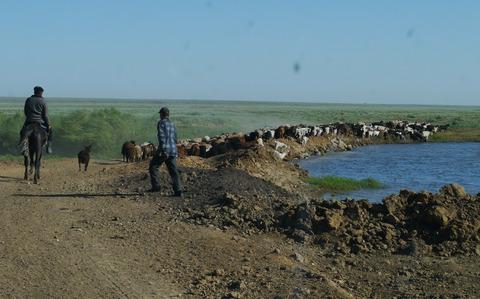当前位置:
X-MOL 学术
›
Glob. Change Biol.
›
论文详情
Our official English website, www.x-mol.net, welcomes your
feedback! (Note: you will need to create a separate account there.)
Post‐Soviet shifts in grazing and fire regimes changed the functional plant community composition on the Eurasian steppe
Global Change Biology ( IF 10.8 ) Pub Date : 2020-10-21 , DOI: 10.1111/gcb.15411 Martin Freitag 1 , Johannes Kamp 1, 2 , Andrey Dara 3, 4 , Tobias Kuemmerle 3, 5 , Tatyana V. Sidorova 6 , Ingrid A. Stirnemann 1, 7 , Frederike Velbert 1 , Norbert Hölzel 1
Global Change Biology ( IF 10.8 ) Pub Date : 2020-10-21 , DOI: 10.1111/gcb.15411 Martin Freitag 1 , Johannes Kamp 1, 2 , Andrey Dara 3, 4 , Tobias Kuemmerle 3, 5 , Tatyana V. Sidorova 6 , Ingrid A. Stirnemann 1, 7 , Frederike Velbert 1 , Norbert Hölzel 1
Affiliation

|
Globally, grasslands are shaped by grazing and fire, and grassland plants are adapted to these disturbances. However, temperate grasslands have been hotspots of land‐use change, and how such changes affect interrelations between herbivory, fire and vegetation are poorly understood. Such land‐use changes are widespread on the Eurasian steppe, where the dissolution of the Soviet Union in 1991 triggered the abandonment of cropland and pasture on globally relevant scales. Thus, to determine how relationships between plant functional composition, grazing and fire patterns changed after the Soviet Union dissolved, we studied a 358,000 km2 region in the dry steppe of Kazakhstan, combining a large field dataset on plant functional traits with multi‐scale satellite data. We found that increases in burned area corresponded to decreases in livestock grazing across large areas. Furthermore, fires occurred more often with high cover of grasses with high leaf dry matter content and thus higher flammability, whereas higher grazing pressure favoured grazing‐tolerant woody forbs and ruderal plants with high specific leaf area. The current situation of low grazing pressure represents a historically exceptional, potentially non‐analogue state. We suggest that the dissolution of the Soviet Union caused the disturbance regime to shift from grazer to fire control. As grazing and fire each result in different plant functional compositions, we propose that this led to widespread increases in grasses and associated changes in steppe plant community structure. These changes have potentially occurred across an area of more than 2 million km2, representing much of the world's largest temperate grassland area, with globally relevant, yet poorly understood implications for biodiversity and ecosystem functions such as carbon cycling. Additionally, future steppe management must also consider positive implications of abandonment (‘rewilding’) because reverting the regime shift in disturbance and associated changes in vegetation would require grazing animals to be reintroduced across vast areas.
中文翻译:

苏联后放牧和火灾的变化改变了欧亚草原上功能性植物群落的组成
在全球范围内,草原是由放牧和火烧形成的,而草原植物则适应了这些干扰。但是,温带草原一直是土地利用变化的热点,人们对这种变化如何影响食草,火和植被之间的相互关系了解得很少。这种土地利用方式的变化在欧亚草原上十分普遍,1991年苏联解体,在全球范围内放弃了农田和牧场。因此,为了确定苏联解体后植物功能成分,放牧和火势之间的关系如何变化,我们研究了一个358,000 km 2哈萨克斯坦干旱草原地区,结合有关植物功能性状的大数据集和多尺度卫星数据。我们发现,燃烧面积的增加与大面积放牧的牲畜减少相对应。此外,高叶干物质含量的草覆盖率高,因此易燃性更高,发生火灾的可能性更大;而放牧压力越高,则越有利于具有高比叶面积的耐草的木本草和叶植物。低放牧压力的当前状况代表了历史上异常的,潜在的非类似状态。我们认为,苏联解体导致骚乱政权从放牧者转向火力控制。由于放牧和火灾会导致不同的植物功能成分,我们认为这导致了草的广泛增加以及草原植物群落结构的相关变化。这些变化可能发生在超过200万公里的区域图2代表了世界上最大的温带草原地区,对全球生物多样性和生态系统功能(如碳循环)具有重要意义,但意义不广。此外,未来的草原管理还必须考虑放弃(“荒野”)的积极影响,因为要恢复混乱状态的转移和植被的相关变化,就需要在广阔的地区重新放牧。
更新日期:2020-12-15
中文翻译:

苏联后放牧和火灾的变化改变了欧亚草原上功能性植物群落的组成
在全球范围内,草原是由放牧和火烧形成的,而草原植物则适应了这些干扰。但是,温带草原一直是土地利用变化的热点,人们对这种变化如何影响食草,火和植被之间的相互关系了解得很少。这种土地利用方式的变化在欧亚草原上十分普遍,1991年苏联解体,在全球范围内放弃了农田和牧场。因此,为了确定苏联解体后植物功能成分,放牧和火势之间的关系如何变化,我们研究了一个358,000 km 2哈萨克斯坦干旱草原地区,结合有关植物功能性状的大数据集和多尺度卫星数据。我们发现,燃烧面积的增加与大面积放牧的牲畜减少相对应。此外,高叶干物质含量的草覆盖率高,因此易燃性更高,发生火灾的可能性更大;而放牧压力越高,则越有利于具有高比叶面积的耐草的木本草和叶植物。低放牧压力的当前状况代表了历史上异常的,潜在的非类似状态。我们认为,苏联解体导致骚乱政权从放牧者转向火力控制。由于放牧和火灾会导致不同的植物功能成分,我们认为这导致了草的广泛增加以及草原植物群落结构的相关变化。这些变化可能发生在超过200万公里的区域图2代表了世界上最大的温带草原地区,对全球生物多样性和生态系统功能(如碳循环)具有重要意义,但意义不广。此外,未来的草原管理还必须考虑放弃(“荒野”)的积极影响,因为要恢复混乱状态的转移和植被的相关变化,就需要在广阔的地区重新放牧。











































 京公网安备 11010802027423号
京公网安备 11010802027423号